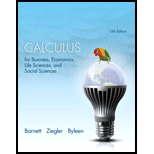
Concept explainers
Income distribution. Using data from the U.S. Census Bureau, an economist produced the following Lorenz curves for the distribution of U.S. income in 1962 and in 1972:
Find the Gini index of income concentration for each Lorenz curve and interpret the results.
Want to see the full answer?
Check out a sample textbook solution
Chapter 6 Solutions
Calculus for Business Economics Life Sciences and Social Sciences Plus NEW
- 26. A certain system can experience three different types of defects. Let A;(i = 1,2,3) denote the event that the sys- tem has a defect of type i. Suppose thatP(A1) = .12 P(A) = .07 P(A) = .05P(A, U A2) = .13P(A, U A3) = .14P(A2 U A3) = .10P(A, A2 A3) = .011Rshelfa. What is the probability that the system does not havea type 1 defect?b. What is the probability that the system has both type 1 and type 2 defects?c. What is the probability that the system has both type 1 and type 2 defects but not a type 3 defect? d. What is the probability that the system has at most two of these defects?arrow_forwardCalculs Insights πT | cos x |³ dx 59 2arrow_forward2. Consider the ODE u' = ƒ (u) = u² + r where r is a parameter that can take the values r = −1, −0.5, -0.1, 0.1. For each value of r: (a) Sketch ƒ(u) = u² + r and determine the equilibrium points. (b) Draw the phase line. (d) Determine the stability of the equilibrium points. (d) Plot the direction field and some sample solutions,i.e., u(t) (e) Describe how location of the equilibrium points and their stability change as you increase the parameter r. (f) Using the matlab program phaseline.m generate a solution for each value of r and the initial condition u(0) = 0.9. Print and turn in your result for r = −1. Do not forget to add a figure caption. (g) In the matlab program phaseline.m set the initial condition to u(0) = 1.1 and simulate the ode over the time interval t = [0, 10] for different values of r. What happens? Why? You do not need to turn in a plot for (g), just describe what happens.arrow_forward
- The following are suggested designs for group sequential studies. Using PROCSEQDESIGN, provide the following for the design O’Brien Fleming and Pocock.• The critical boundary values for each analysis of the data• The expected sample sizes at each interim analysisAssume the standardized Z score method for calculating boundaries.Investigators are evaluating the success rate of a novel drug for treating a certain type ofbacterial wound infection. Since no existing treatment exists, they have planned a one-armstudy. They wish to test whether the success rate of the drug is better than 50%, whichthey have defined as the null success rate. Preliminary testing has estimated the successrate of the drug at 55%. The investigators are eager to get the drug into production andwould like to plan for 9 interim analyses (10 analyzes in total) of the data. Assume thesignificance level is 5% and power is 90%.Besides, draw a combined boundary plot (OBF, POC, and HP)arrow_forward4. Solve the system of equations and express your solution using vectors. 2x1 +5x2+x3 + 3x4 = 9 -x2+x3 + x4 = 1 -x1-6x2+3x3 + 2x4 = -1arrow_forward3. Simplify the matrix expression A(A-B) - (A+B)B-2(A - B)2 + (A + B) 2arrow_forward
- 10 5 Obtain by multiplying matrices the composite coordinate transformation of two transformations, first x' = (x + y√√2+2)/2 y' = z' (x√√2-2√2)/2 z = (-x+y√√2-2)/2 followed by x" = (x'√√2+z'√√2)/2 y" = (-x'y'√√2+2')/2 z" = (x'y'√√2-2')/2.arrow_forwardNot use ai pleasearrow_forward4 The plane 2x+3y+ 6z = 6 intersects the coordinate axes at P, Q, and R, forming a triangle. Draw a figure and identify the three points on it. Also find vectors PQ and PR. Write a vector formula for the area of the triangle PQR and find its value.arrow_forward
 Algebra & Trigonometry with Analytic GeometryAlgebraISBN:9781133382119Author:SwokowskiPublisher:Cengage
Algebra & Trigonometry with Analytic GeometryAlgebraISBN:9781133382119Author:SwokowskiPublisher:Cengage Algebra and Trigonometry (MindTap Course List)AlgebraISBN:9781305071742Author:James Stewart, Lothar Redlin, Saleem WatsonPublisher:Cengage Learning
Algebra and Trigonometry (MindTap Course List)AlgebraISBN:9781305071742Author:James Stewart, Lothar Redlin, Saleem WatsonPublisher:Cengage Learning Functions and Change: A Modeling Approach to Coll...AlgebraISBN:9781337111348Author:Bruce Crauder, Benny Evans, Alan NoellPublisher:Cengage Learning
Functions and Change: A Modeling Approach to Coll...AlgebraISBN:9781337111348Author:Bruce Crauder, Benny Evans, Alan NoellPublisher:Cengage Learning College AlgebraAlgebraISBN:9781305115545Author:James Stewart, Lothar Redlin, Saleem WatsonPublisher:Cengage Learning
College AlgebraAlgebraISBN:9781305115545Author:James Stewart, Lothar Redlin, Saleem WatsonPublisher:Cengage Learning Glencoe Algebra 1, Student Edition, 9780079039897...AlgebraISBN:9780079039897Author:CarterPublisher:McGraw Hill
Glencoe Algebra 1, Student Edition, 9780079039897...AlgebraISBN:9780079039897Author:CarterPublisher:McGraw Hill





